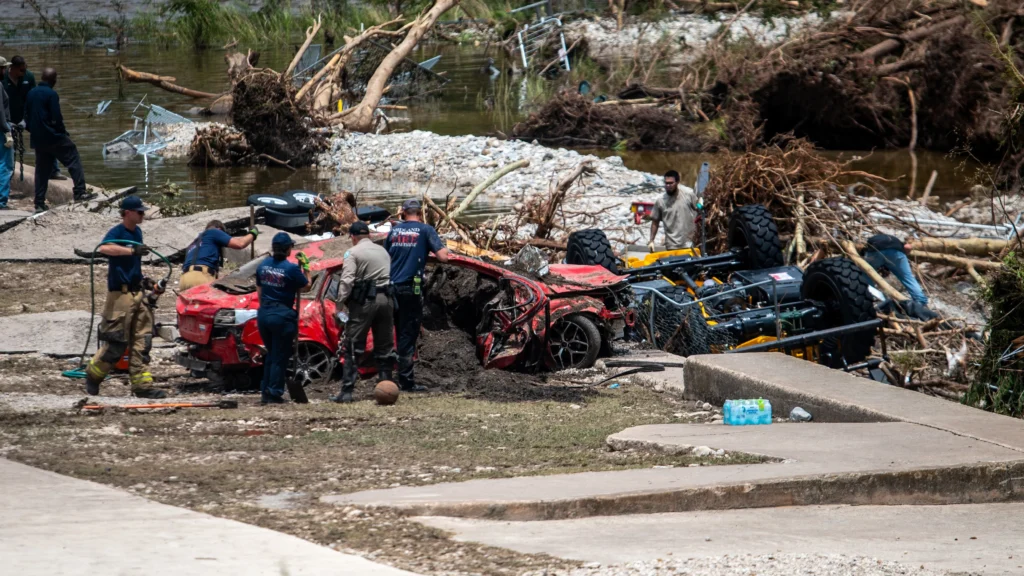
🌊 Texas Drowns Under Torrential Rain: Worst Floods in Decades
On July 7–8, 2025, the U.S. state of Texas faced its worst flooding disaster in nearly 50 years, after a relentless downpour submerged cities across the Hill Country region, leaving at least 38 confirmed dead and hundreds more missing.
From San Marcos to Kerrville, floodwaters swept through homes, highways, and entire neighborhoods. Local officials describe the situation as “catastrophic,” with more rain still expected.
📍 Affected Areas: Where the Floods Hit Hardest
The Texas Hill Country, known for its rugged terrain and scenic riverbanks, became a deadly floodplain as rivers breached their banks and dams overflowed.
Most affected counties:
- Hays County
- Comal County
- Travis County
- Kendall County
- Gillespie County
Entire towns like Wimberley and Fredericksburg were partially underwater, prompting mass evacuations and aerial rescues.
🕯️ Casualties & Missing Persons
- Death toll as of July 8: 38 confirmed
- Missing persons: Over 200, with some possibly swept downstream
- Injuries: Hundreds treated for hypothermia, shock, or injury
- Evacuations: 12,000+ residents relocated to temporary shelters
Local sheriffs and FEMA officials warn that numbers may rise as rescue teams comb through the debris and submerged structures.
🚨 Emergency Response in Full Swing
Texas Governor Greg Abbott has declared a state of emergency across 20 counties and requested federal disaster aid.
Deployed resources:
- 2,000+ National Guard troops
- 65+ rescue helicopters
- 500+ boats assisting with evacuations
- Mobile water filtration units and medical camps
FEMA teams have arrived with satellite communication hubs, temporary housing kits, and search dogs.
📹 Viral Videos Capture the Devastation
Social media has been flooded with shocking footage of:
- Cars being swept off highways
- People climbing onto rooftops to escape rising waters
- A hospital in New Braunfels being evacuated via boat
- A video showing a bridge collapse in Kerrville, with vehicles still crossing
These clips are trending under the hashtag #TexasFlood2025 and are being used by emergency teams to identify rescue locations.
🌧️ What Caused the Sudden Flooding?
Meteorologists report that the flooding was caused by a stalled low-pressure system pulling moisture from the Gulf of Mexico into central Texas, causing 24-hour rainfall totals of over 18 inches in some areas.
This, combined with already saturated ground and narrow river valleys, created the perfect storm.
Contributing factors:
- Climate change: Warmer air holds more moisture
- Urban sprawl: Less permeable ground = more runoff
- Delayed alerts in some rural zones
This flood event is already being compared to the Memorial Day Flood of 2015—but is expected to surpass it in damage and fatalities.
💡 What You Can Do to Help
If you’re in the U.S. or abroad and want to contribute:
Donate to:
- American Red Cross: https://www.redcross.org/
- Texas Disaster Relief Fund: https://tdrfund.org
- Feeding Texas: https://www.feedingtexas.org/
Volunteer (if in Texas):
- Call 2-1-1 or register at www.volunteertx.org
Avoid sending physical items unless specifically requested by local authorities.
🏚️ Estimated Damages & Infrastructure Impact
Preliminary estimates suggest:
- Over $2.8 billion in damage
- 14 bridges and highways completely destroyed
- 18,000+ homes damaged or destroyed
- 500+ businesses flooded, especially in small towns
Power outages have affected over 350,000 residents, and many rural communities remain cut off due to collapsed roads and communication breakdowns.
🔮 What’s Next?
Weather experts say more rain may fall over the next 48 hours, though intensity is expected to decrease.
Local officials have issued the following guidance:
- Avoid traveling in flood-hit counties
- Boil water advisories are in effect
- Continue to report missing persons to Texas DPS and Red Cross Safe & Well
📣 Final Word: A Wake-Up Call for Climate Preparedness
The 2025 Texas floods are not just a natural disaster—they’re a climate wake-up call. As global temperatures rise and weather patterns intensify, extreme rainfall events are becoming more frequent and more dangerous.
For governments, communities, and individuals, this tragedy is a stark reminder of the need for resilient infrastructure, early warning systems, and emergency preparedness.

